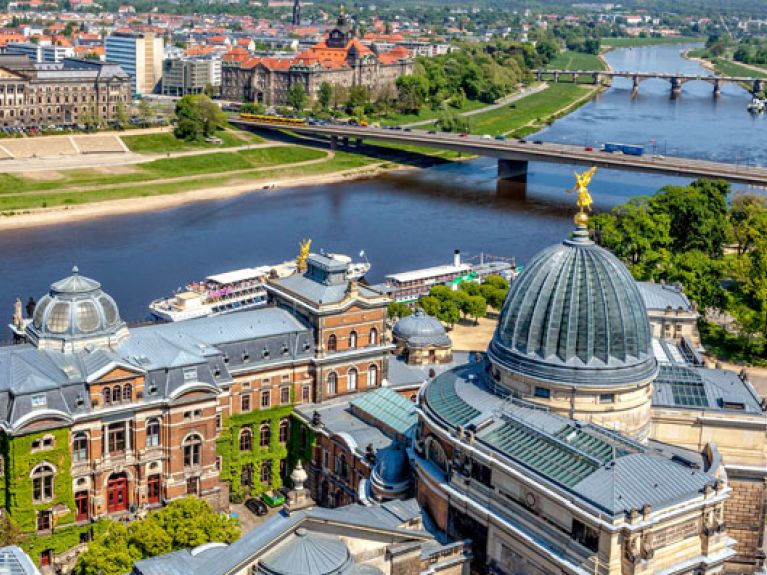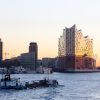And on it flows – the Elbe, river of unity
How has life on the Elbe changed since German reunification? A journey along the former border.

Rivers are considered supporting players, settings for what takes place on their banks. It’s a role that fails to do them justice, as Mark Twain has conclusively demonstrated. In his case it’s the Mississippi, the “grand old river”, that’s the story teller, that drives the plot. In terms of size, of course, the Elbe – which stretches 1,094 kilometres from its source in the Czech Republic’s Giants Mountains to its mouth on the North Sea – is no comparison. And yet it, too, has played a leading role again and again. It brought cities considerable prosperity; it carried the Reformation from Wittenberg out into the world; and on one occasion its flooding may even have decided a German Bundestag election. But first and foremost, for years it formed part of the inner-German border.
“A river is a mover of goods and ideas,” says Ludwig Güttler. His office in Dresden‘s Old City is just a stone’s throw from the Elbe. It’s from here that he runs the Frauenkirche Dresden Foundation, an institution dedicated to the upkeep of the church, which is also situated close by. The church’s location is no accident, Güttler believes, but rather determined by the Elbe. People have always erected special buildings in slightly elevated locations close to the water’s edge, he explains. “It‘s a place of power.” But one which, following the air raids on Dresden at the end of the Second World War, remained for decades a gaping wound. Güttler, who played trumpet with the Dresden Philharmonic Orchestra in the 1970s, constantly passed the ruins of the church on his way to rehearsals. He became an advocate for the church’s reconstruction, but in the GDR the plan was not practicable. “When the Communist system collapsed, we knew: it’s now or never.”
But many years were to pass before the “new” Frauenkirche was consecrated in 2005. Today, it is once again a key element in the Old City’s architectural ensemble. When Güttler looks out of his office window, he sees visitors from all over the world flocking to the edifice that more than any other in Germany stands for successful reconstruction and the overcoming of war and destruction.
Not all stories that take place on the Elbe end as well as that of Dresden’s cultural heritage. Industry on the river’s eastern bank found it difficult to gain a foothold in reunited Germany. The technological head start enjoyed by businesses in western Germany was too great, and those in the east were ill-prepared to hold their own in an open, globalised market. Only a few large companies survived. One of them is located some 30 kilometres downriver: the Meissen State Porcelain Manufactory.
Founded in 1710, the company attaches great importance to tradition. Managing Director Tillmann Blaschke even serves his guests mineral water in porcelain beakers. Tradition was also what helped Meissen through the years following the fall of Communism, Blaschke believes. “In a craft industry like ours, there was not such a sharp disparity in terms of productivity between eastern and western companies.”
A second answer to the question of what set Meissen apart from other long-standing businesses in East Germany is closely tied up with the career of Liane Werner. Now the company’s sales manager, she joined the manufactory in 1987, shortly after completing her studies at the School of Economics in East Berlin, the only higher education institution in the GDR at which it was possible to study foreign trade. She chose the subject, she explains, “because it allowed you to travel.” Her subsequent employer was a foreign exchange earner for the GDR, which is why Meissen was one of the few companies that were allowed to maintain international trade relations largely independently. That meant it was somewhat better equipped than other companies to weather the transition to a market economy in 1990. “Not a great deal changed for us,” says Werner.
Even so, the past 25 years have not been a smooth ride for the manufactory, which is owned by the State of Saxony. “Tableware and the art of fine dining have changed in Germany,” says Managing Director Blaschke. Today, the porcelain dinner service for festive occasions is no longer a must in every household. That’s why Meissen has extended its range of products to include fashion goods, jewellery and home accessories and is seeking to further raise its profile in the world’s growth markets. As recently as May 2015, Blaschke opened a new flagship store in Shanghai.
Let’s return from Asia to the Elbe and move on to Torgau. That’s where the famous photograph of Soviet and American troops shaking hands on the damaged bridge over the Elbe was taken in 1945. But the moment of peace captured by the photographer on that day was not to last. With the founding of the GDR in 1949, the Elbe became an international border. After the building of the Berlin Wall in 1961, the river also became a death strip. The term “wall deaths” almost makes us forget that here, too, people were killed while fleeing – while attempting to swim across the Elbe or overcome the border fortifications. “The border stretched for 94 kilometres along the Elbe, from Lütkenwisch/Schnackenburg to Boizenburg/Lauenburg – the same length as the metal lattice fence that was erected between the river and the dyke on the East German side,” writes Uwe Rada in his book The Elbe. “People on the right bank could hear the river when waves washed against its shore, but they could no longer see it.”
In Wittenberg, at the Elbe’s 214 kilometre mark, the exhibition in the House of History museum focuses more on everyday life in the GDR – complete with Trabi cars and Sandmännchen TV puppets. There’s evidently a demand for this sort of “Ostalgie” – a German pun that translates as nostalgia for life in East Germany. There are few visitors to the museum on this particular morning, and the town as a whole is quiet, as if gathering strength for the big anniversary that’s scheduled for 2017. It will then be 500 years since Martin Luther nailed his 95 theses to the door of the Schlosskirche. Apart from its historic portal, the church is covered with tarpaulins – it’s being renovated. On the church tower there’s a poster proclaiming “We are preserving a World Heritage site – be sure to preserve your curiosity.”
Moving on along the river, we come upon people out canoeing on this sunny day. For many years it would have been totally inconceivable to use the Elbe for recreational purposes. Its waters were considered a noxious cocktail that was best kept at a distance. In Dessau, there are people who know more about the subject. The city has been home to the Federal Environment Agency (UBA) since 2005. You can’t miss the UBA with its unusual architecture and colourful facade. Its photovoltaic power system, solar panels and geothermal heat exchangers have even won it prizes for sustainability. Inside, it looks as if a grown-up has realised a childhood dream of a giant treehouse. The approximately 900 employees reach their offices via an indoor garden, floating stairs and bridges. The signs on the doors say “Marine Protection” or “Arctic and Antarctic Protection”. Jens Arle is responsible for inland waterways. The question currently on the biologist’s mind is how to implement the EU Water Framework Directive in Germany. The aim is to achieve “good ecological status” of all bodies of water by 2027. The Elbe still has a long way to go on that score.
“Before 1990, the Elbe was one of Europe’s most polluted rivers,” says Arle. The concentrations of lead and nitrogen, for example, were many times higher than in other rivers. Fishes were dying and the river’s ecosystem had reached tipping point – the Elbe was, to all intents and purposes, dead. Quite a few things have happened since then. “Many of the GDR’s high-polluting industrial plants have shut down or now use more modern technologies. Environmental legislation has been introduced and the sewage treatment plants, too, are now much more efficient.” Pollutant levels are falling and the Elbe’s native fauna and flora are returning: “Migratory fish like the sturgeon und the salmon had long since disappeared; now reintroduction programmes are under way.” The Elbe has been successfully resuscitated, but the patient is not yet in top form.
The inhabitants of Dessau have rediscovered their love for the river on their doorstep – that’s evident from the annual Elbe Bathing Festival. Biologist Arle is not normally among the swimmers. He prefers exploring the water meadows. In both West and East Germany, the Elbe was considered borderland, so the landscape on both sides of the river remained relatively unspoiled. Today‘s Elbe River Landscape biosphere reserve, a UNESCO-recognised protected area, is closely linked with the Garden Kingdom of Dessau-Wörlitz. Visitors to the regal parks of the World Heritage site stroll past castles, lakes – and dykes. Dealing with floods is part of life on the Elbe. That’s why certain dates have a particular significance for the people who live here – 2013 and 2002 are two such dates.
In June 2013, Magdeburg, 60 kilometres downstream from Dessau, was among the many cities on the Elbe to experience the most catastrophic flooding in their history. And that was after the disaster of August 2002, which was declared a “once-in-a-century flood”. At the time, Federal Chancellor Gerhard Schröder travelled to the affected areas, and shortly afterwards his SPD-Alliance 90/The Greens coalition won the Bundestag elections.
The threat of floods is not the only challenge that Magdeburg has to cope with. Many cities in the former GDR have to contend with severe population loss. Magdeburg – a city that Otto the Great transformed into a metropolis in the Middle Ages – is shrinking, too. Since 1990, its population has declined from approximately 290,000 to 230,000. Nearly one in four homes stood empty in 2000. Johannes Wöbse is responsible for urban development at the city’s planning department. He and his colleagues have received no less a task than tailoring a new suit for “Otto”, as the local marketing people call the city. His old one has become far too baggy.
“In GDR times, huge residential areas were built here,” says Wöbse, as he steers his car through Neu Olvenstedt. Today, this district in the north-west of Magdeburg has only half the number of inhabitants it had before reunification. It is dominated by massive, drab prefabricated blocks. Neu Olvenstedt is the district with the largest proportion of elderly people – and the biggest social problems. The city authorities and the owners of the residential blocks have already done a great deal: some of the blocks have been demolished to make way for single-family dwellings; others have been refurbished with funding from the Urban Renewal East programme so that they no longer bear much resemblance to “prefabs” – the upper storeys have been removed and the facades revamped. Nevertheless, Neu Olvenstedt remains Magdeburg’s problem child.
Situated directly on the riverside, Buckau is quite a different matter. The former fishing village has reinvented itself – morphing from industrial quarter to trendy neighbourhood – and today is Magdeburg’s youngest district. Families are moving into refurbished old properties; commercial premises that once stood empty are being converted into galleries and boutiques; and on the banks of the Elbe home owners are realising their dream of waterside living. “Buckau has turned the corner,” says Wöbse.
Waterside living has long been a popular concept in Hamburg, just 100 kilometres from the Elbe estuary. In 2024, it could take on a completely new quality. The Free and Hanseatic City of Hamburg has bid to host the Olympic Games. There are plans to provide accommodation for the athletes on cruise ships anchored in the harbour. For the Elbe to feature prominently in this grand celebration of international understanding would be a fitting honour for this European river that has long been situated in the middle of Germany. ▪

